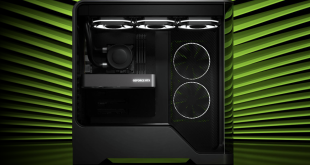Everyone loves the Nvidia GTX Titan but sadly few can afford the high price of ownership. Right now the best price is around £830, from Overclockers UK. While gaming is only one of the strengths of this particular solution very few gamers will be able to budget £800-£900 just for the graphics card.
This is why the GTX780 has proven popular with the wealthy enthusiast gamer. It offers 90% of the GTX Titan gaming performance and is generally priced around £300 less. The ASUS GTX780 Direct CU II OC which we reviewed today costs £629.99 on pre-order from Overclockers UK, so you are saving around £200 over a GTX Titan.
There is no doubt that this Direct CU II is one of the best coolers that ASUS have ever designed. Noise emissions are lower than some of the custom GTX760 coolers we have tested in the last month, and when gaming the core peaked at only 65c, which is 3c better than the eVGA GTX660 ti superclocked card. These really are remarkable results for ASUS.
A standard clocked GTX780 can handle the latest Direct X 11 titles at 2560×1600 and this Asus model is marginally faster out of the box, due to a slight core clock enhancement.
This is only part of the story however.
There is incredible headroom on this core, undoubtedly supplemented by the custom 6 phase power design. While every sample will give slightly different results, our review sample delivered almost 25 percent core clock headroom, finally stable at 1,100mhz. This pushed in game performance past the GTX Titan, and we documented a 2,000 point increase in 3DMark 11, from 13,000 points to just over 15,000 points.
If you have around £600 to spend on a graphics card and want it predominately for gaming, then the Asus GTX780 Direct CU II OC sets a new benchmark in this sector, especially when factoring in the incredible core clock headroom.
You can buy it from Overclockers UK on this page.
Pros:
- cooler design is class leading.
- huge core clock headroom for overclocking.
- £200 cheaper than a basic GTX Titan.
- very quiet under load.
- built to last, including a backplate on PCB.
- 6 phase power delivery.
Cons:
- very modest core clock speeds out of the box.
- still a lot of money.
Kitguru says: Dont want to shell out over £800 for a Titan? this is as close as it gets for £200 less.

 KitGuru KitGuru.net – Tech News | Hardware News | Hardware Reviews | IOS | Mobile | Gaming | Graphics Cards
KitGuru KitGuru.net – Tech News | Hardware News | Hardware Reviews | IOS | Mobile | Gaming | Graphics Cards



Love this card, but its still a bit rich for my blood. are they doing this with the GTX 770?
thats a crazy OC for such a high end board.
I love the nvidia boards in this generation, but they are all so expensive. im still looking at getting a 760 as I only game at 1080p. think its enough. waiting on the ti version if there is one coming out soon
Great review, but for under half the price I would recommend getting a GTX 760. I got one last week and it’s a great card for around the £210 mark.
Great review.
I wish you guys would actually find a truly STABLE overclock. Just like everyone else you get a clock speed that’s stable for a 10-minute benchmark, but not for real-world games. It’s misleading and people who buy and overclock the card are disappointed to find that truly stable clocks are much lower than those in reviews. I haven’t seen anyone across all GTX 780 threads get a truly stable core clock above 1040MHz, even for the water cooled custom ones. You should really run intensive games for 3-5 hours to get your overclocking results, and you’ll see they are nowhere near as good as you thought.
I played a few games on it for hours and it was stable at 1040mhz (no artifacting on memory or core and no hard locks etc). Its only misleading if people think that every graphics card in that particular range will hit those speeds, but they don’t as we mention in many reviews and I hope our audience know from 3 years of reviews here that every card can deliver VERY different results. Same as when you are overclocking processors.
We attempt to make everything as transparent as possible.
I bought one of these and the card is stable at 1204mhz with a 200mhz boost on the memory (couldnt get the memory overclock they achieved to become stable) but this clock speed was playable through the first half of crysis 3 (got tired of the game after a few hours) Then played borderlands 2 for a few more hourse. I finished off my testing with some fur-mark burn in tests to insure stability (2 hour burn in test). My room did get quite a bit warmer during this gaming period, but my window was open and outside was cold. The temps held steady at 73-76 Celsius for most of the duration of testing with the max temp being 77 degrees Celsius.